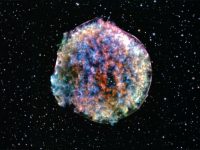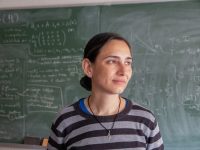A new way of looking at the sky
Neutrino telescopes
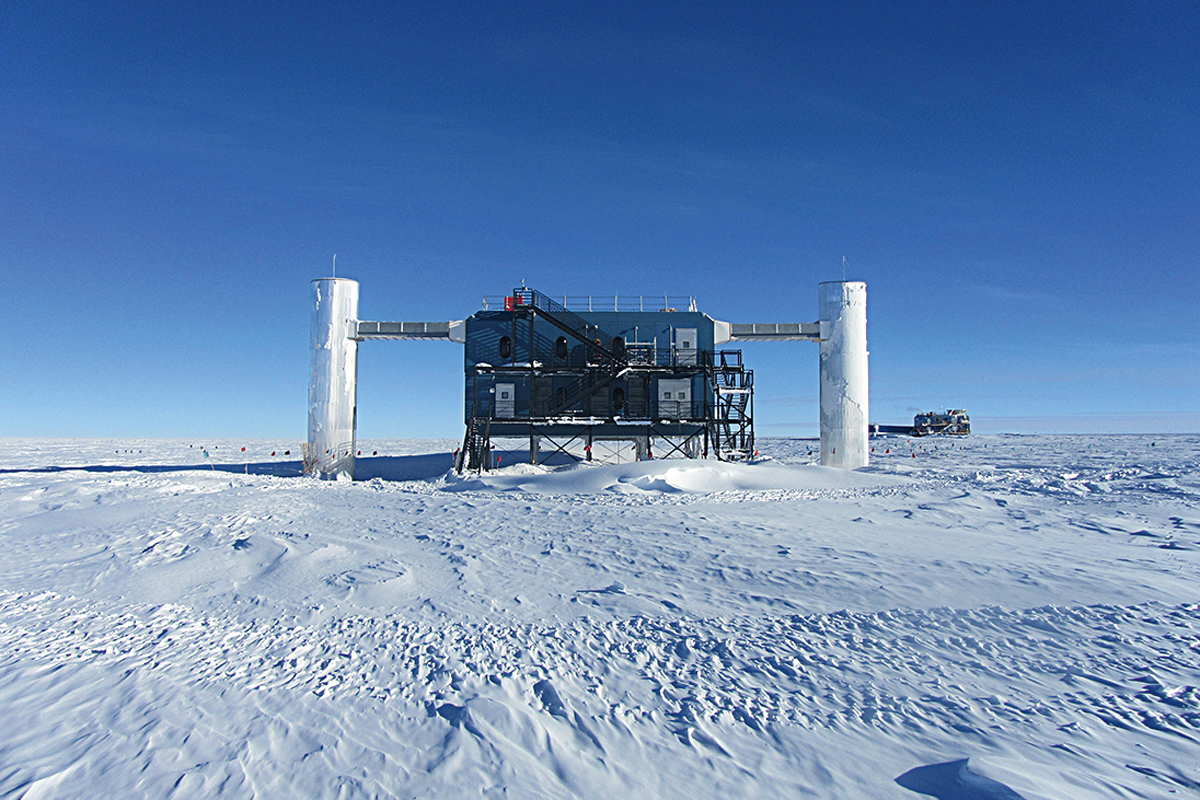
Neutrinos are weakly-interacting neutral particles, which makes them powerful sources of information about the most energetic processes in the universe, such as the origin of ultra-energetic cosmic rays or gamma-ray bursts. However, a price must be paid in order to detect them: gargantuan detectors at the bottom of the sea or under the Antarctic ice are required. The detection of the first high-energy cosmic neutrinos in 2013 by the IceCube observatory represented the start of so-called neutrino astronomy, a new way of observing the universe, which can play a key role in future discoveries. In this article, we describe how neutrino telescopes work, as well as the different initial configurations that made this new twenty-first century astronomy possible.
Keywords: neutrino astronomy, neutrino telescopes, astroparticle physics, IceCube, KM3NeT.
Introduction
Since the moment human beings first appeared on Earth, we have felt attracted by the exploration of the universe. While, for centuries, our exploration consisted solely of observing the stars with the naked eye, later, from the development of Galileo’s optical telescope to the launch of the Hubble telescope, our advancement has been spectacular. Photon astronomy, which uses all of the wavelengths in the electromagnetic spectrum, has boosted our ability to look farther and farther away, both in terms of distance and in terms of energy. However, photons are not the only messengers that can provide information. The improvements of our knowledge in particle physics and the recent advances in the development of experimental techniques have allowed us to extend our exploration to the most energetic phenomena in the universe, by means of the detection of other types of emissions such as cosmic rays and very-high-energy neutrinos.
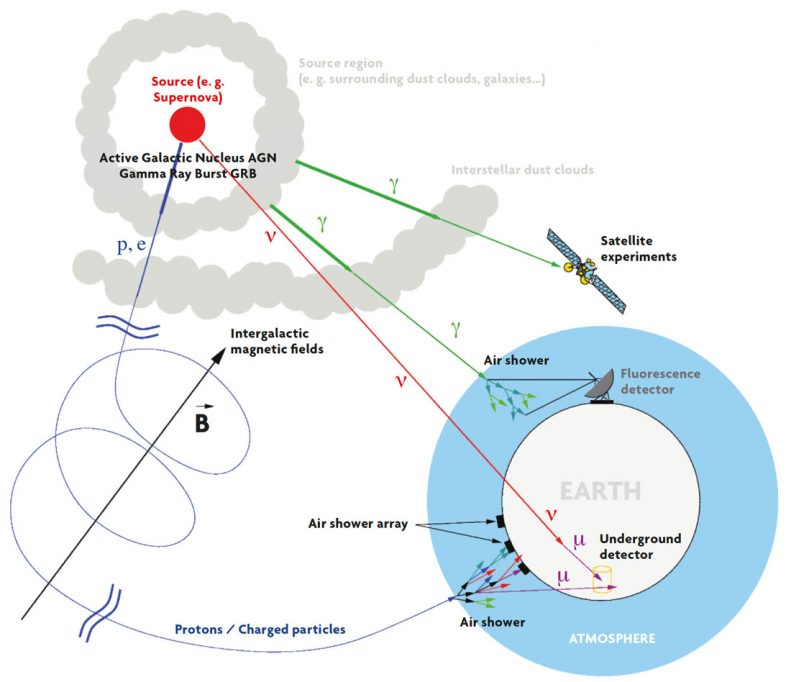
Figure 1. Multi-messenger astronomy. Cosmic rays (p, e), except in extremely high energies, are deflected by intergalactic magnetic fields. Gamma rays (γ), on the other hand, are not deviated but rather, absorbed by the interstellar medium. However, neutrinos (ν) are neither deflected nor absorbed. When they are registered by the relevant detectors for their characteristics, these messengers provide information about their sources. In the case of neutrinos, these are detected by observatories located under the sea or under ice, where neutrinos produce a relativistic muon (μ) when they interact with the medium (see Figure 2). / Wolfgang Rhode
For instance, current detectors have observed gamma ray sources with energies above 10,000 GeV, some of which could not be identified as emitters in other wavelengths. Cosmic rays with energies higher than 1020 eV concentrated in a single nucleus, i.e., approximately the energy of a tennis ball during a serve, have also been observed. This energy is several orders of magnitude higher than the energy produced in other large accelerators such as CERN’s LHC (Large Hadron Collider) in Geneva, where the Higgs boson was recently discovered. On the other hand, in 2013 the IceCube neutrino telescope located in Antarctica, announced the detection of cosmic neutrinos with energies higher than 1015 eV (Aartsen et al., 2013). The latest discovery in this regard was gravitational waves, produced in the collision of two black holes, which was detected by the Laser Interferometer Gravitational-wave Observatory (LIGO) in September 2015 (Abbott et al., 2016). Understanding the most violent part of the universe is currently one of the greatest challenges for astroparticle physics. Each of these messengers provides characteristic information about their sources, which can complement each other giving rise to what we know as multi-messenger astronomy. Among all of them, neutrinos can play a key role because they are weakly-interacting neutral particles, and so they can traverse the universe without being absorbed or deviated (Figure 1).
Cosmic rays, discovered by Victor Hess in 1912, are charged particles coming from outer space that constantly bombard our atmosphere. We currently know that they mainly consist of protons and nuclei and that their energy spectrum comprises more than ten orders of magnitude. We assume that the highest-energy cosmic rays are accelerated in astrophysical sources such as Active Galactic Nuclei or Gamma Ray Bursts, where huge amounts of energy can be released. However, we have not been able to prove this hypothesis, because cosmic rays are diverted by interstellar magnetic fields while on their journey to Earth. Nonetheless, cosmic ray acceleration models predict that a fraction of the accelerated particles interact with the matter or photons at their source, creating neutrinos that escape the acceleration region. Since neutrinos are neutral particles and cannot be deviated by interstellar magnetic fields, detecting them can help us to identify their source, thus solving a century-old problem.
«La comprensió de la cara més violenta de l’univers és actualment un dels majors reptes de la física d’astropartícules»
The detection of neutrinos rather than gamma rays also presents several advantages, because the latter are absorbed by the intergalactic medium when they interact with extragalactic background radiation, mainly infrared and visible light. Thus, for example, it is not possible to detect photons of over 10 TeV from sources farther than 100 Mpc. On the other hand, neutrinos provide a method for exploring the universe in higher energy ranges and at farther distances. Moreover, they can serve as a probe to study very dense regions, from which photons cannot escape.
Neutrinos are elementary particles with no electrical charge, barely any mass, and are only susceptible to weak interactions. They were postulated by Pauli (1930) as a desperate remedy to save energy and angular momentum conservation in radioactive beta decay. Neutrinos were detected for the first time by Clyde Cowan and Frederick Reines (Cowan, Reines, Harrison, Kruse, & McGuire, 1956) thanks to the flow of antineutrinos of the Handford nuclear reactor. Due to their small cros-section , they were detected 26 years after they were first hypothesised because of their small cross section. About three trillion neutrinos (3 × 1012) coming from the universe cross each square centimetre of the Earth’s surface every second (mostly from the Sun), but only one in every billion (109) interacts with matter.
«L’astronomia de fotons ha augmentat la capacitat per a arribar cada vegada més lluny tant en distància com en energia. Però els fotons no són els únics missatgers que poden aportar-nos informació»
In 1962, an experiment at the Brookhaven National Laboratory discovered a second type of neutrino that produced only muons when they interacted with matter, unlike the neutrinos from beta decay, which produced only electrons (Danby et al., 1962). Today we know there are three neutrino families or «flavours» (νe, νµ, ντ), each associated with one of the leptons, electronic, muonic, or tauonic (e, µ, τ), from the standard model of particle physics.
Neutrino telescopes
Detection principle
While the neutrinos produced by the Sun and by supernova explosions have energies of the MeV order of magnitude, those produced in cosmic ray accelerators are much more energetic, from hundreds of GeV to millions of PeV. The fundamental problem for neutrino detection in this energy range is that, because they only interact weakly, enormous volumes of matter are necessary to increase the probability of neutrino interaction. In 1960, Moisey Markov (1960) suggested using the Antarctic ice or the water from the bottom of the sea as a natural medium, and using the Cherenkov light coming from the charged particles produced as a result of the interaction of neutrinos with matter to detect them; this idea gave rise to what became neutrino telescopes.
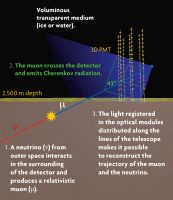
Figure 2. Detection principle of neutrino telescopes. Cosmic neutrinos can cross the Earth and reach the proximity of the detector. When they interact with the water, ice, or bedrock nuclei, they can produce a relativistic muon that can induce Cherenkov light, which allows researchers to reconstruct the trajectory of the muon and the neutrino, as detailed in the diagram. / François Montanet
A neutrino telescope is essentially a three-dimensional matrix of optical sensors (photomultipliers) located in an optically transparent medium, such as water or ice, and enclosing an enormous amount of matter. This is why they are built at the bottom of the sea, in sufficiently deep lakes, or under the Antarctic ice. The «natural» size needed to detect the expected fluxes is around one cubic kilometre. Cosmic neutrinos can go through the Earth (which acts as a shield to other particles) and reach the proximity of the detector. When they interact with the water, ice, or the nuclei of particles in the bedrock, they can produce, thanks to what we call charged-current interactions, a relativistic muon that can induce Cherenkov light because it travels faster than the speed of light in water. From the amount of light detected and the arrival times registered by the photomultipliers for the Cherenkov photons, we can reconstruct the trajectory of the muon. For neutrinos of energies above 10 TeV, the muon is almost aligned with the neutrino incident and the position of its source in the sky can be measured (Figure 2).
Neutrino telescopes can also detect neutrinos of other flavours (e.g., electronic and tauonic) although the signal produced is an almost spherical particle shower instead of a straight line. In this case, it is more difficult to know the direction of the neutrino, but easier to measure their energy.
«ICECUBE és actualment el telescopi de neutrins més gran del món i el primer a detectar els neutrins còsmics d’alta energia»
This innovative detection technique is extremely efficient: it uses the same natural medium as a target, detector, and shield against background noise. The latter is related to avoiding atmospheric muons as much as possible and is discussed in more detail in the next section. In addition, Cherenkov light can travel tens of metres from the produced muon or shower, and so the number of photosensors needed to cover a given volume is reasonable, making construction of these telescopes economically and logistically viable. It is interesting to note that, due to the distance both muons and Cherenkov light can travel, the effective volume of the detector goes far beyond (hundreds of metres farther) the instrumented volume.
Signal and background
Not all the events registered in a neutrino telescope come from cosmic neutrinos. There are two types of background events that can affect the signal in a neutrino telescope: atmospheric muons and atmospheric neutrinos. Both originate in the interaction of cosmic rays with the Earth’s atmosphere. These interactions produce secondary-particle showers that contain many particles such as pions, kaons, muons, heavier hadrons, as well as neutrinos. Of all of them, muons are the most pervasive, and their flux on the Earth’s surface is several orders of magnitude larger than the expected signal. To avoid the enormous number of atmospheric muons as far as possible, neutrino telescopes are built very deep into water or ice (~2,000 m). But even with this enormous shield, the flow of atmospheric muons reaching the detector is so high that distinguishing a cosmic muon from an atmospheric muon would be like trying to identify if it is raining or not while standing under a waterfall. However, since muons cannot cross the Earth entirely but neutrinos can, the atmospheric muon background can be reduced using the Earth as a filter, so that only events reconstructed as ascending are selected for further analysis. This means that, paradoxically, a neutrino telescope observes the part of the sky opposite to that which a conventional optical telescope located in the same place would.

Figure 3. The IceCube telescope is located deep under ice in the South Pole. It consists of 86 lines with 5,160 optical sensors in total and is buried between 1,450 and 2,450 m deep, as seen in the diagram. In the pictures, we can see the surface laboratory, as well as one of over 5,000 modules starting its 2,500-metre descent into the Antarctic ice. /IceCube Collaboration,
Unfortunately, the atmospheric neutrinos produced in the antipodes of the detector can cross the Earth and produce an ascending muon, indistinguishable from a muon produced by a cosmic neutrino. Atmospheric neutrinos constitute what is known as the irreducible background, which can only be discriminated using statistical techniques. In the skymap containing the neutrinos detected by the telescope, atmospheric neutrinos are randomly distributed, while cosmic neutrinos group together in privileged directions corresponding to the positions of their sources. This way, the accumulation of events in particular directions reveals the existence of such sources. On the other hand, atmospheric neutrinos present lower energies than those from astrophysical sources, so an excess of very energetic events can provide evidence for the presence of cosmic neutrinos. In fact, this is how they were detected by IceCube. Additionally, detection of neutrinos in coincidence with another type of signal from the same position can also be crucial to determine signals.
The experience acquired by operating these telescopes, particularly IceCube, has allowed experts to conceive other ways of reducing background noise. For example, the external part of the detector can be used as a «veto» detector: the atmospheric muons that accompany atmospheric neutrinos (background) will activate the external photomultiplier tubes. Therefore, if we restrict our selection to events whose first signal is detected within the detector, we can eliminate this type of background. This strategy also discriminates atmospheric neutrinos, because they are usually accompanied by muons produced in the same particle shower as them. Depending on the objectives of the analysis, new and innovative forms of selection have appeared which have made these types of detectors much more versatile than was initially supposed. For instance, they currently lead in the indirect search for dark matter or could, in the future, shed light on the properties of neutrinos.
Initial attempts
The first initiative to build a neutrino telescope started in 1976 with the DUMAND project (Deep Underwater Muon and Neutrino Detector), whose objective was to build a 4,800 m deep submarine detector near the shores of Hawaii (Babson et al., 1990). The first line of photomultipliers and environmental sensors was installed in 1993, but communication was lost after ten hours of operation. The project was cancelled in 1996 due to a lack of funding.
«El 2013, IceCube va anunciar la detecció de dos neutrins amb energies superiors al PeV, batejats amb els noms d’Ernie i Bert i que fins al moment han estat els neutrins més energètics detectats»
The first experiment that was able to successfully operate a neutrino telescope was the Baikal project (Aynutdinov et al., 2009), located 1,100 m deep in Baikal lake in Siberia (the deepest lake in the world). The first design (NT200) was completed in 1998 and had 8 lines with 192 optical modules in total. In 2005, it was extended with three more lines, increasing its sensitivity by a factor of 4. At present, the Baikal Collaboration is working in a more ambitious expansion: Baikal-GVD (Gigatron Volume Detector), consisting in the construction of several new blocks the size of the original NT200 (Avrorin et al., 2015).
El telescopi de neutrins AMANDA (Antartic Muon and Neutrino Detector Array) va ser el primer telescopi construït davall el gel del pol sud, a l’estació polar Amundsen-Scott (Andres et al., 2001). Construït entre els anys 1996 i 2000, estava format per 19 línies amb 667 fotomultiplicadors en total i ocupava un volum cilíndric de 200 metres de diàmetre i 500 metres d’altura, soterrat entre 1.500 i 2.000 metres de profunditat.
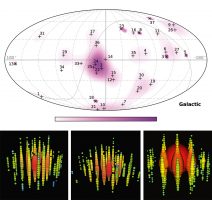
The AMANDA neutrino telescope (Antarctic Muon and Neutrino Detector Array) was the first telescope built under the South Pole ice, in the Amundsen-Scott polar station (Andres et al., 2001). It was built between 1996 and 2000, included 19 lines with 667 photomultipliers in total, occupied a cylindrical volume of 200 m in diameter and 500 m in height, and was buried between 1,500 and 2,000 m deep. However, AMANDA stopped working in 2005 and thus, the construction of IceCube (Halzen & Klein, 2010) began and was configured around AMANDA. IceCube consists of 86 lines, with 5,160 photomultipliers in total, and is located between 1,450 and 2,450 m deep (Figure 3). Being in the South Pole, it observes the northern hemisphere sky 100 % of the time. It also contains a Deep Core with 6 additional lines with a higher density of photomultipliers, which allows the array to detect neutrinos under 100 GeV.
The birth of high-energy neutrino astronomy
After two years of operation, IceCube announced, in 2013, the detection of two neutrinos with energies over the PeV threshold. They were called Ernie and Bert and, to date, they are the most energetic neutrinos that have ever been detected. A more exhaustive analysis confirmed the detection of 26 neutrinos with energies above 30 TeV with a 4.8 σ significance (Aartsen et al., 2013). Later, the analysis was updated with an additional year of data and the total number of such neutrinos went up to 37 – including a third high-energy neutrino above PeV, named Big Bird – achieving a significance of 5.7 σ (Figure 4). The most recently published results describe 54 events with energies higher than 60 TeV (Aartsen et al., 2015). These events are considered the discovery of the first high-energy cosmic neutrinos and the birth of neutrino astronomy.
IceCube is currently the largest neutrino telescope in the world and the first to detect high-energy cosmic neutrinos. Two expansions are planned in the near future. The first, called PINGU (Precision IceCube Next Generation Upgrade), will consist of a detector with a high density of photomultipliers for low-energy measurements at around the GeV threshold. The second, called IceCube-Gen2, will expand IceCube to 10 km3 in order to locate the astrophysical sources of cosmic neutrinos.
Neutrino telescopes in the Mediterranean
ANTARES
In May 2008, the ANTARES collaboration (Astronomy with a Neutrino Telescope and Abyss RESsearch) completed the construction of the first submarine telescope with an approximate volume of 0.1 km3 (Ageron et al., 2011). ANTARES is located 2,475 m deep and about 40 km away from the shores of Toulon, France. It consists of 885 photomultipliers in total, distributed in twelve 450-metre-long lines which are anchored to the seafloor with a ballast at their base and kept vertical with a buoy at the top. The lines are 60~70 m away from each other horizontally and are distributed to form a cylinder. The photomultipliers are enclosed in glass spheres, designed to withstand pressures of up to 260 atmospheres, and each line is divided into 25 different storeys, 14.5 m from each other. The first is located 100 m above the seafloor, and in each successive storey, a titanium structure supports 3 photomultipliers separated 120 degrees from each other and facing 45 degrees downward, to facilitate the detection of ascending neutrinos (Figure 5).

All these lines are attached to a junction box which connects them to the station located on the shore via an electro-optical cable. A system of acoustic hydrophones, compasses, and inclinometers installed in different positions in the detector allows researchers to see the movement of the lines caused by marine currents and thus, to calculate the position of the modules with a precision of ~15 cm. In order to know the position of the neutrino sources with a precision higher than several tenths of a degree, the photomultipliers must be temporally synchronised with a resolution of less than a nanosecond. This is achieved through a time calibration system based on pulsing light sources, LEDs, and lasers, distributed throughout the detector.
«Es necessiten nous detectors amb un volum entre 10 i 100 vegades major que IceCube per a continuar en l’exploració dels successos més energètics de l’univers»
Its small size prevented ANTARES from detecting any source of cosmic neutrinos, but the telescope still provided very competitive results, setting limits for the flux of cosmic neutrinos and in the indirect search of dark matter. On the other hand, the technology developed by ANTARES for the construction of the first submarine neutrino telescope paved the way for next-generation telescopes.
KM3NeT
The only way to increase the number of cosmic neutrinos detected is by building larger detectors. In this sense, KM3NeT (KM3 Neutrino Telescope), whose expected size will be several km3, represents the successor to ANTARES in the Mediterranean (Adrián-Martínez et al., 2016). KM3NeT will have a modular structure with several autonomous blocks distributed in different locations: Toulon (France), Capo Passero (Italy), and Pylos (Greece). The design is conceptually similar to its predecessors and each block consists of a three-dimensional structure with 115 lines. Each of these lines will hold 18 optical modules; instead of including only one photomultiplier, each of them will include 31 smaller photomultipliers distributed throughout the surface of the optical module (Figure 6).
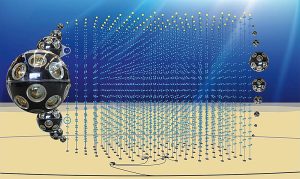
Figure 5. The ANTARES neutrino telescope (on the left, artistic rendering) is located 2,500 m deep and 40 km away from the shores of Toulon. It consists of twelve 450-metre-long lines with almost 900 optical sensors in groups of three, as seen in the photograph on the right. All these lines are attached to a junction box which connects them to the station located on the shore via an electro-optical cable.
/ KM3NeT
On the other hand, the KM3NeT detector will have two different configurations depending on its two scientific objectives: ARCA and ORCA. The ARCA configuration (Astroparticle Research with Cosmics in the Abyss), with a higher volume and more separation between the lines, will focus on the search for astrophysical sources of very-high-energy cosmic neutrinos. Conversely, the ORCA configuration (Oscillation Research with Cosmics in the Abyss), is much more dense, with lines closer to each other and less space between optical modules, to allow it to detect lower-energy neutrinos, both to measure the neutrino mass hierarchy and to carry out indirect searches for dark matter. The implementation of the project is organised in different stages. During the first stage, already underway, 7 lines will be installed at the French site and 24 in the Italian site. During the second stage, 115 lines will be installed in France (ORCA) and 230, separated in two blocks, in Italy (ARCA). Finally, the third stage will consist of 690 lines in total, divided between the different locations. KM3NeT is one of the great European scientific infrastructures within the framework of the European Strategy Forum on Research Infrastructures (ESFRI), mandated by the European Commission to suggest the essential scientific infrastructures necessary for the advancement of science in Europe.
Perspectives and future
Neutrino astronomy has finally taken off and is destined to make great scientific advances. Since its deployment, IceCube has already detected more than fifty high-energy neutrinos, mostly from outer space, which poses a great number of questions both for astrophysics and for particle physics. However, the number of events is too small for researchers to be able to find the answers. The fact that neutrinos only interact weakly implies the construction of gigantic detectors that can capture enough cosmic neutrinos and distinguish them from those originating in the Earth’s atmosphere. Despite being the largest neutrino telescope currently in operation, IceCube is not sufficiently large to accumulate the necessary statistics required to solve our questions and so new detectors with volumes between 10 and 100 times larger than IceCube are necessary to carry on the exploration for the most energetic events in the universe. Thus, both KM3NeT, the successor of ANTARES, and IceCube-Gen2, the successor of IceCube, are destined to bring us closer to finding answers to many questions in the next decade.
Aartsen, M. G., Abbasi, R., Abdou, Y., Ackermann, M., Adams, J., Aguilar, J. A., … Zoll, M. (2013). Evidence for high-energy extraterrestrial Neutrinos at the IceCube Detector. Science, 342, 1242856. doi: 10.1126/science.1242856
Aartsen, M. G., Abraham, K., Ackermann, M., Adams, J., Aguilar, J. A., Ahlers, M., ... Zoll, M. (2015, 30 de juliol-6 d’agost). Observation of astrophysical neutrinos in four years of IceCube data. The 34th International Cosmic Ray Conference (ICRC), La Haia (Països Baixos). Consultat en: http://arxiv.org/abs/1510.05223
Abbott, B. P., Abbott, R., Abbott, T. D., Abernathy, M. R., Acernese, F., & Ackley, K., … Zweizig, J. (2016). Observation of gravitational waves from a binary black hole merger. Physical Review Letters, 116(6), 061102. doi: 10.1103/PhysRevLett.116.061102
Andres, E., Askebjer, P., Bai, X., Barouch, G., Barwick, S. W., Bay, R. C., … Young, S. (2001). Results from the AMANDA high energy neutrino detector. Nuclear Physics B, 91(1-3), 423–430. doi: 10.1016/S0920-5632(00)00971-3
Adrián-Martínez, S., Ageron, M., Aharonian, F., Aiello, S., Albert, A., Ameli, F., … Zúñiga, J. (2016). Letter of Intent for KM3NeT2.0. Journal of Physics G: Nuclear and Particle Physics, 43(8), 084001. doi: 10.1088/0954-3899/43/8/084001
Ageron, M., Aguilar, J. A., Al Samarai, I., Albert, A., Ameli, F., André, M., ... Zúñiga, J. (2011). ANTARES: The first undersea neutrino telescope. Nuclear Instruments and Methods in Physics Research, 656(1), 11–38. doi: 10.1016/j.nima.2011.06.103
Avrorin, A. D., Avrorin, A. V., Aynutdinov, V. M., Bannasch, R., Belolaptikov, I. A., Bogorodsky, D. Y., … Zurbanov, V. L. (2015). Status and recent results of the Baikal-GVD project. Physics of Particles and Nuclei, 46(2), 211–221. doi: 10.1134/S1063779615020033
Aynutdinov, V., Avrorin, A., Balkanov, V., Belolaptikov, I., Bogorodsky, D., Budnev, N., … Zhukov, V. (2009). The Baikal neutrino experiment: Physics results and perspectives. Nuclear Instruments and Methods in Physics Research, 602(1), 14–20. doi: 10.1016/j.nima.2008.12.012
Babson, J., Barish, B., Becker-Szendy, R., Bradner, H., Cady, R., Clem, J., … Wilson, C. (1990). Cosmic-ray muons in the deep ocean. Physical Review D, 42(11), 3613–3620. doi: 10.1103/PhysRevD.42.3613
Cowan Jr., C. L., Reines, F., Harrison, F. B., Kruse, H. W., & McGuire, A. D. (1956). Detection of the free neutrino: A confirmation. Science, 124(3212), 103–104. doi: 10.1126/science.124.3212.103
Danby, G., Gaillard, J. M., Goulianos, K., Lederman, L. M., Mistry, N., Schwartz, M., & Steinberger, J. (1962). Observation of high-energy neutrino reactions and the existence of two kinds of neutrinos. Physical Review Letters, 9(1), 36–44. doi: 10.1103/PhysRevLett.9.36
Halzen, F., & Klein, S. R. (2010). IceCube: An instrument for neutrino astronomy. Review of Scientific Instruments, 81(8), 081101. doi: 10.1063/1.3480478
Markov, M. A. (1960, 25 d’agost-1 de setembre). On high energy neutrino physics. Proceeding for the 10th Annual International Conference on High Energy Physics (ICHEP), Rochester (EUA).
Pauli, W. (1930). Letter to Tubingen conference participants. Consultat en: http://goo.gl/XDdTu3

